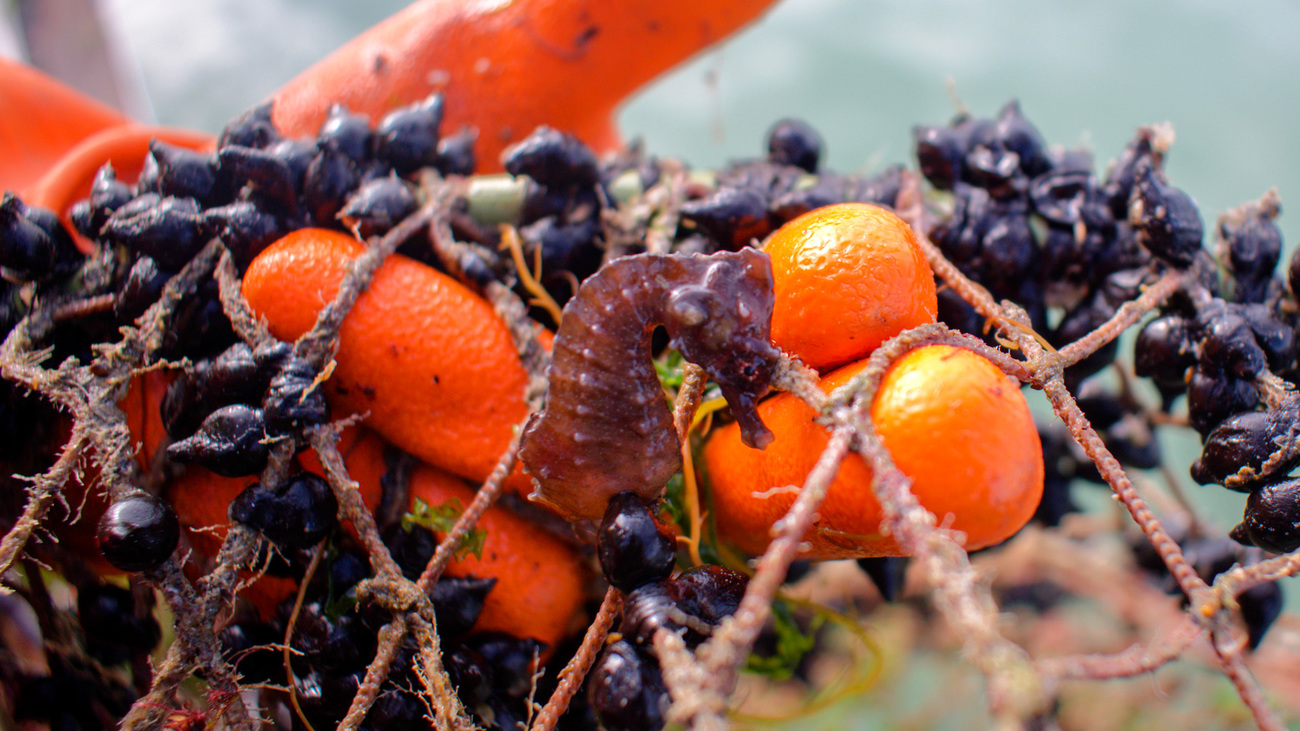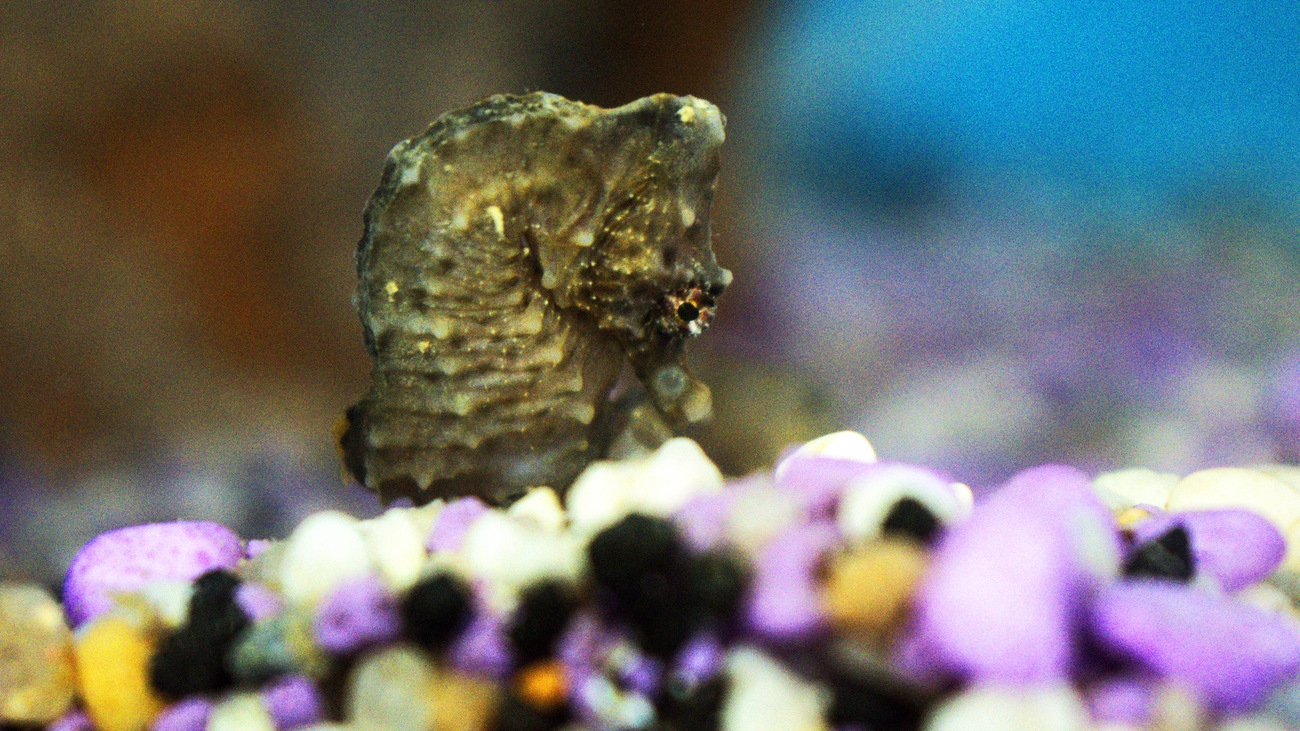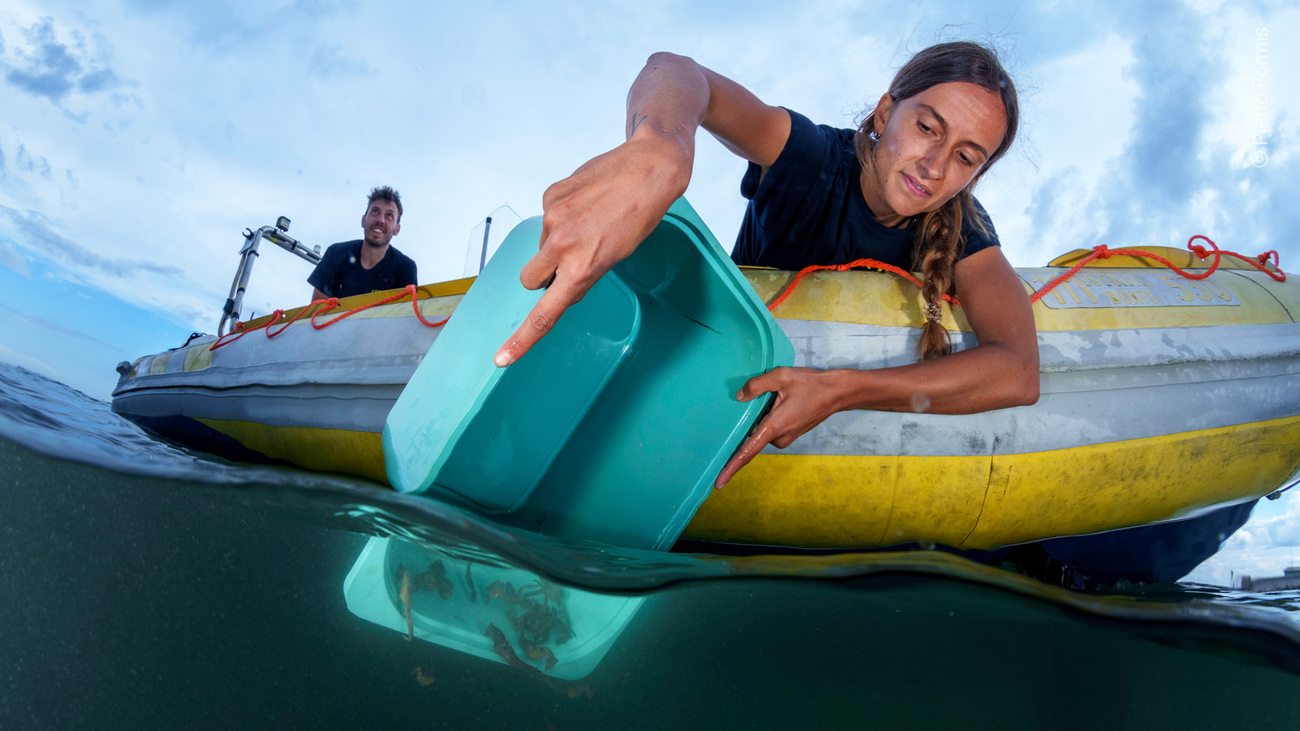Seahorses
What is a seahorse?
A seahorse is an unusual type of fish found in shallow waters in temperate and tropical climates. As their name suggests, all seahorses have a horse-shaped head. Their long bodies stay upright as they swim and end in a curly tail that can be used to grip marine vegetation and each other. Like many fish, they have a fin on their back and each side of their head—but they don’t have scales. Instead, bony plates cover their bodies.
There are around 50 different species of seahorse, all of which have a lot in common. But there are some key differences too, most notably in their size. The smallest seahorse, Satomi’s pygmy seahorse, measures just 1.5 centimeters (0.6 inches) from the top of its head to the end of its tail. The largest seahorse species, the big-bellied seahorse, can measure up to 34 centimeters (13 inches).
Because seahorses adapt to their habitat, they also vary in appearance, ranging from spotted to speckled to striped. They camouflage themselves to hide from predators by changing colour and growing or absorbing the spines on their bodies to mimic their surroundings. Pygmy seahorses, for example, grow lumps on their bodies that resemble the bumps of sea fans. Others have spines that make them appear more like seaweed.
Another surprising seahorse fact is that males—not females—are the ones who give birth to young. Females put their eggs into a pouch located at the base of a male seahorse’s tail. Males then fertilise the eggs and give birth to live baby seahorses in a labour that can last up to 12 hours.
Seahorses are preyed upon by crabs, rays, skates, and marine birds. Young seahorses are eaten by other fish. Seahorses also play a crucial role as predators in seagrass, mangrove, coral reef, and estuary ecosystems.
What is a seahorse’s scientific name?
Seahorses are part of the genus Hippocampus. This name comes from two Greek words—hippos, meaning ‘horse’, and kampos, which means ‘sea monster’. There are around 50 different species of seahorse. These include, among others:
- Satomi’s pygmy seahorse (Hippocampus satomiae)
- Big-bellied seahorse (Hippocampus abdominalis)
- Spiny seahorse (Hippocampus histrix)
- Snort-snouted seahorse (Hippocampus hippocampus)
- Spotted seahorse (Hippocampus kuda)
Are seahorses endangered?
The three-spot seahorse, the hedgehog seahorse, and the great seahorse are all listed as vulnerable on the IUCN Red List, among 13 total vulnerable species.
Three seahorse species are endangered or critically endangered. White’s seahorse and the Knysna seahorse are listed as endangered. The Walea soft coral pygmy seahorse is listed as critically endangered.
Where do seahorses live?
All seahorses live in marine habitats in temperate and tropical regions. They are usually found among seaweed, seagrass, mangrove roots, and coral reefs in shallow water. Some species also live in estuaries, as they can tolerate water that is less salty than the ocean.
To give just a few examples, Denise’s pygmy seahorse lives in the Pacific Ocean, from Indonesia to Vanuatu. Satomi’s pygmy seahorse lives in the Indian and Pacific Oceans from the Coral Sea to the Bay of Bengal. The big-bellied seahorse lives in the seas around South Australia and New Zealand. The short-snouted seahorse is found in the Mediterranean Sea and parts of the North Atlantic Ocean.
Threats
Like many marine animals, seahorses face a variety of threats. These include illegal trade, overfishing, bycatch, habitat erosion, and climate change.
Illegal trade
Despite protections and trade bans, the illegal trade in seahorses continues. The fish are taken from their natural habitat, killed, and dried out. They are then sold as trinkets and for use in traditional Chinese medicine. Some seahorses are caught and kept alive to be sold as exotic pets.
Overfishing and bycatch
Overfishing is one of the top threats to seahorse species. Some seahorses are caught intentionally for illegal trade, but commercial fishing boats unintentionally catch millions of seahorses every year as bycatch.

Habitat erosion and climate change
Seahorse habitats are being impacted by climate change and other human activity.
For example, the Walea soft coral pygmy seahorse lives among coral. Destructive fishing practices—like poison and blast fishing—and coral mining are negatively impacting this habitat. Coral reef bleaching, caused by warming ocean temperatures, is also a concern.
The Knysna seahorse lives in an area where expanding human settlements and industrial activities are impacting water quality. Chemicals and other pollutants are entering the estuary and boats are damaging this seahorse’s seagrass habitat.
FAQs
Is a seahorse a fish?
Seahorses are a type of tiny fish. Like other fish, they live in water, have a swim bladder (an organ filled with air that helps fish float), and breathe through gills. However, unlike other fish, they do not have tail fins. Seahorses get their name because of the shape of their head, which looks like the head of a horse.
Do seahorses have gills?
Yes, seahorses have gills. But these gills are different to the gills of other fish. Whereas most bony fish have their gills arranged in four neat gill arches, seahorses have ‘tufted’ gills that occur in clumps.
What do seahorses eat?
Seahorses are carnivores. They eat small crustaceans and invertebrates, including krill, copepods, fish larvae, and shrimp.
Adult seahorses eat 30 to 50 times a day when there’s enough food available. Baby seahorses eat up to 3,000 pieces of plankton per day. Seahorses eat so regularly because they don’t have a stomach in which to store food. Instead, they have an inefficient digestive tract that can only absorb some of the food they eat.
Seahorses don’t have teeth either. They use their long, thin snouts to probe into nooks and crannies, seeking out prey. Their snouts can expand to eat larger prey and suck up their food.
Because they can’t swim very well, seahorses are ambush predators. They stay still and make use of their excellent camouflage, waiting for their prey to pass by before rapidly sucking food into their mouths.
Do male seahorses give birth?
A female seahorse is responsible for laying eggs in the male’s ‘brood pouch’, which sits at the top of his tail, on the front side of his body. Depending on the seahorse species, the male carries anywhere from 50 to 1,500 eggs.
While in the male’s pouch, the eggs are fertilized. They receive oxygen and food and remain in the pouch for up to 45 days. While pregnant, the male sits and rests until it’s time to give birth.
Once the eggs have hatched, the male seahorse gives birth in a process that can take up to 12 hours. He releases the baby seahorses—known as fry—into the ocean, where they are left to fend for themselves.
Baby seahorses are at risk from predators and ocean currents as soon as they leave the safety of the pouch. Their survival rate is less than 0.5%.
How do seahorses reproduce?
Seahorses are known for their elaborate courtship behavior. Males and females swim together, mirroring each other’s actions. They entwine their tails and change colour as they dance together.
After the courtship, the female uses an ovipositor—a kind of tube—to transfer her eggs into the male’s brood pouch. The male then fertilizes the eggs and keeps them in his pouch until they are hatched and ready to birth.
Once the baby seahorses have left the pouch, a male seahorse can receive another brood of eggs almost immediately.
Do seahorses mate for life?
Seahorses were commonly thought to mate for life, but recent research shows that they may only stay with the same partner for a few months or the duration of a breeding season.
However long the relationship lasts, it’s a very close one. Every morning, seahorse couples meet in the male’s territory to perform their dance, which can last for hours. This is a way to strengthen their bond and assess the reproductive readiness of their mate.
What color are seahorses?
Like chameleons, seahorses can change color. They use this to camouflage themselves and hide from predators.
In seagrass habitats, seahorses tend to be green. In coral reef habitats, seahorses are more brightly coloured. In sandy habitats, seahorses are sand colored with small black dots.
Seahorses also change color to attract and maintain a bond with their mate. During a courtship ritual, seahorses can change from black to white.
Interestingly, seahorses also have eyes like chameleons’. Their eyes can move independently of one another and in all directions.

How long can a seahorse live?
A seahorse tends to live between one and five years. Larger species usually live longer than smaller species.
How do seahorses swim?
Seahorses aren’t the best swimmers. They swim slowly, in an upright position.
Pectoral fins, on both sides of the head, help with stability and steering. A dorsal fin, located on a seahorse’s back, beats frantically—between 30 and 70 times per second—to create forward movement. To move up and down in the ocean, seahorses adjust the amount of air they hold in their swim bladders.
Because they are such weak swimmers, it’s easy for seahorses to become exhausted and get swept away in currents or stormy seas. They use their prehensile tail to grip onto seagrasses and other plants to try and prevent this.
Can you get seahorses as pets?
Keeping seahorses as exotic pets is difficult, costly, and bad for marine ecosystems, as it involves removing wild animals from their natural habitats.
As well as being impractical, keeping a seahorse as a pet helps to sustain the illegal fishing trade. As part of the pet trade, seahorses are removed from their natural habitats in large numbers, damaging populations and impacting species’ survival in the process.
Our work
IFAW supports the Seamaster Seahorse Rescue Center, Italy’s first dedicated seahorse hospital. An initiative by the CESTHA research group, the Center plays a pivotal role in the conservation of endangered seahorse species that live in the Adriatic Sea. Their mission is to preserve seahorse species by providing specialized care and rehabilitation for seahorses that are injured or are victims of bycatch, with the goal of releasing them back into protected marine areas.
In 2024 alone, the Center saved the lives of 1,200 seahorses. They rescue most seahorses from March to August, when seahorses are often victims of bycatch from cuttlefish fishing. Their work to save these vulnerable animals is crucial during this period.

With IFAW’s support, the Seamaster Seahorse Rescue Center is able to expand its facilities and make a greater impact. This includes turning a large storage area into a year-round rescue facility and installing new tanks. With this expanded facility, CESTHA marine biologists estimate the Center will be able to rescue 2,000 seahorses every year.
How can you help?
Seahorses act as a flagship species for coastal ecosystems. These fascinating fish are highly vulnerable to habitat degradation. So, if seahorses are struggling to survive, it’s likely that other marine animals are struggling, too.
You can help to protect seahorses, ocean habitats, and other marine life by supporting IFAW. Our marine conservation projects around the world help make our oceans a safer and healthier place for animals and people.